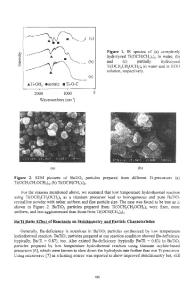Low Temperature Synthesis of Si-C-N and C-N Films by IR-laser Assisted ECR-PECVD
- PDF / 1,228,758 Bytes
- 6 Pages / 391.5 x 607.5 pts Page_size
- 54 Downloads / 245 Views
PVD and CVD combination, a low deposition temperature becomes possible to reduce C and Fe interdiffusion. Third, laser ablation can provide addition elements from solid material during film growth to increase the availability of various materials in a CVD process. Since the C3N4 has the structure analog of Si3N 4 and the bond length of beta-Si 3N 4 is longer than the beta-C 3N4 , the temperature of forming beta-Si 3N4 crystal is likely lower than it in beta-C 3N 4 crystal formation. An approach to form beta-C 3N 4 crystallites in amorphous films at low temperatures is by substitution of C for Si in the beta-Si 3N 4 network. In synthesizing SiC and Si 3N 4 by sol-gel method, CO and catalyst metals promote the formation of Si3N 4 structures N 2 mixture was used to study the fabrication of Si-C-N films. at low temperatures [11]. oC2/ Since film growth is significantly affected by the source gases, our investigation focuses on the effects of varying the gas ratio on the types of bonds formed. EXPERIMENT Fig. I is a schematic diagram of the growth chamber. An infrared pulsed laser beam (Continuum Nd:YAG laser, operating at 1064 nm wavelength) was introduced into the growth chamber and was focused at a location 2 cm above the substrate surface. A rotating Si target was located 5 cm from the substrate. The laser beam was defocused on the target surface with a 0.6 J/cm2 energy density, and the laser repetition rate was 25 Hz. These ablated Si species were provided for Si-C-N film growth. Stainless steel substrates were pasted by silver on a heater surface and a thermocouple was clamped onto the heater surface to measure growth temperatures. Before loading, substrates were ultrasonically cleaned by immersion in acetone and methanol solvents, respectively, for 10 minutes after they had been mechanically polished using 800-grade sandpaper, 1 pim, and 0.3 ýtm size alumna powders. The power of the ECR source used to dissociate gas molecules was 500- 1000 W. During C-N film growth, the focused laser beam was only used to dissociate CH4 and N2 gases. Before films grew, the chamber was pumped down to a base pressure - 106 Torr. Then hydrogen gas was introduced till the chamber pressure was 500 mTorr. Substrates were cleaned for 30 minutes by the hydrogen plasma generated by 500 W of ECR microwave power at a temperature of 150 "C. Source gases were introduced into the growth chamber after the hydrogen gas had been evacuated. A total gas flow rate was 300 sccm. Films were grown with 500 - 1000 W of ECR microwave power and at a pressure of 550 mTorr. For Si-C-N film growth, substrate temperature was 200 1C, with a number of different CO 2/ N2 mixtures. For C-N films, mixtures of CH4/ N 2 were used and the growth temperatures were 200 - 650 'C. The film thickness is 500 nm. Gases
.. . .
..
-.
Pulsed Nd:YAGSiTre Laser Beam
Pump
Fig.1
Heater
The schematic diagram of the growth chamber.
366
Low angle Fourier transform infrared reflection (LAFTIR) spectroscopy, Raman spectroscopy, atomic force microscopy (AFM), and x-ray diffra
Data Loading...










